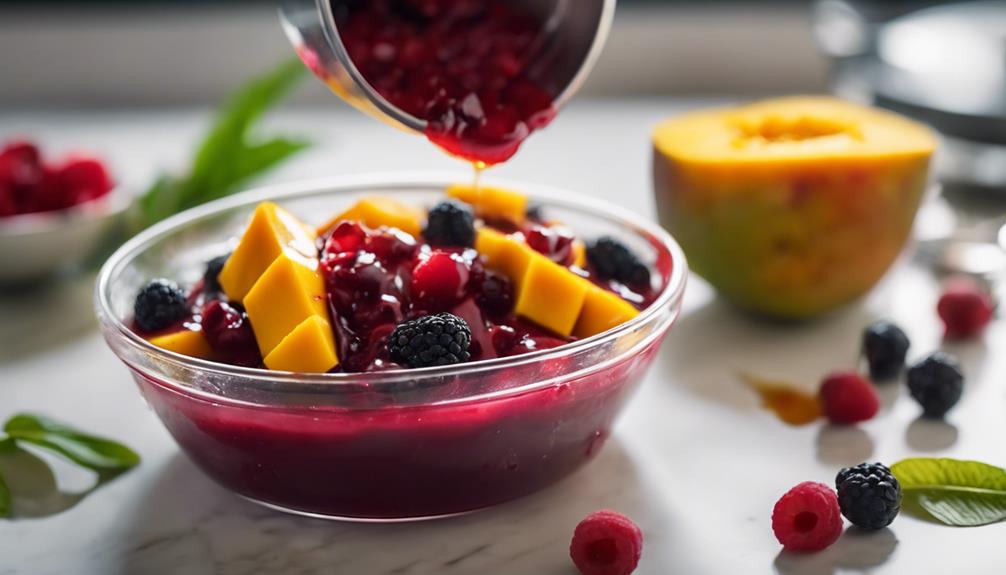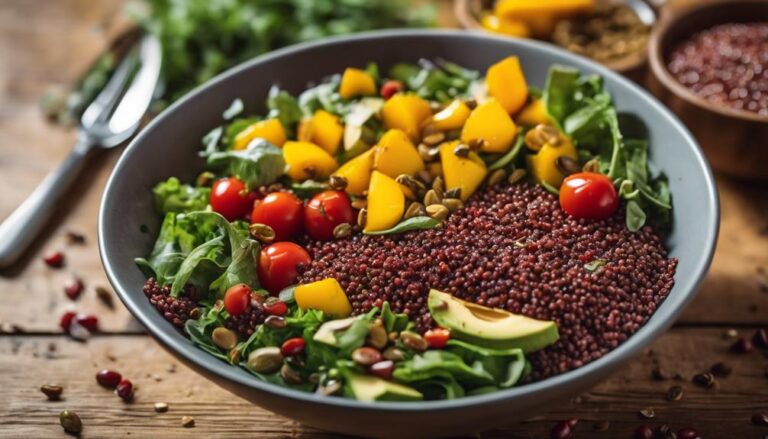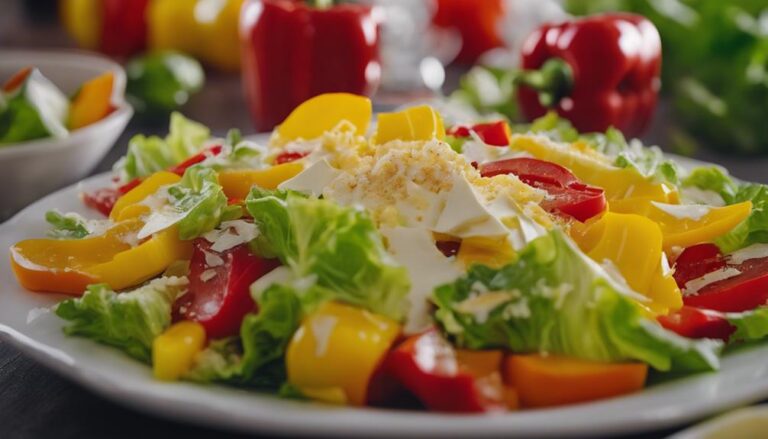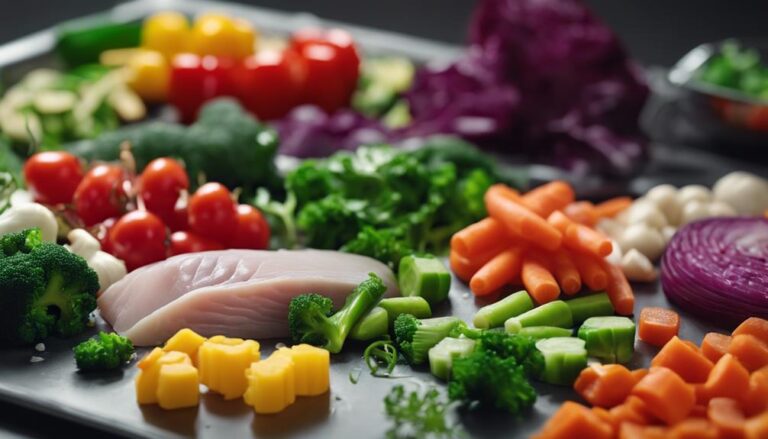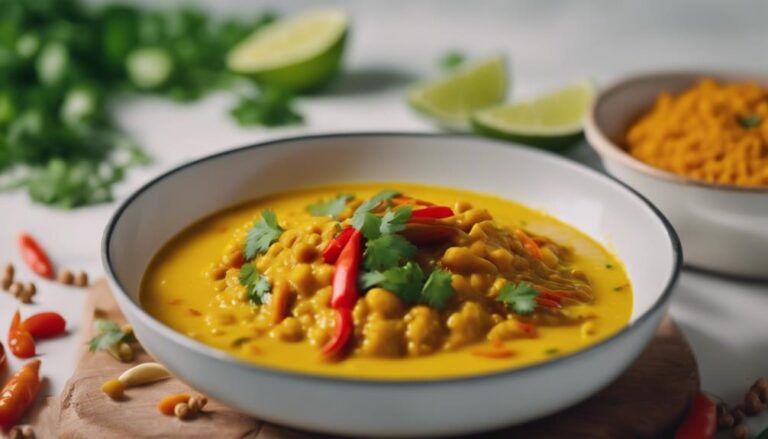Dessert Sous Vide Mango and Red Berry Compote
You're ready to elevate your dessert game with a sophisticated twist on classic flavors. Imagine the sweet juiciness of mangoes perfectly complemented by the tartness of red berries, all harmoniously blended in a sous vide masterpiece. The precise cooking method guarantees an infusion of flavors that will tantalize your taste buds, but there's more to this dessert than meets the eye. Stay tuned to discover the secrets behind creating a visually stunning and delicious finale to your meal.
What You Will Learn Here
- Sous vide technique ensures precise temperature control for flavor infusion.
- Mango and red berry compote benefits from consistent texture and enhanced flavor.
- Vacuum-sealing fruits preserves natural textures for a delightful dessert.
- Controlled cooking process guarantees optimal flavor pairing and texture consistency.
- Exotic fruits like mango and red berries bring vibrant tastes to sous vide desserts.
Historical Mango Cultivation

Mango cultivation dates back centuries, originating in South Asia and spreading across tropical regions worldwide.
Techniques for growing this delicious fruit have evolved over time, adapting to different climates and agricultural practices.
The global mango trade plays a significant role in connecting producers with consumers, making this fruit a staple in many cuisines around the world.
Mango Origins
Originally cultivated in South and Southeast Asia, the mango has a rich history of cultivation dating back thousands of years. Mango varieties are diverse, each offering a unique flavor profile, from sweet and tropical to tangy and citrusy. This fruit not only delights the taste buds but also provides various health benefits, thanks to its high vitamin C content, which boosts immunity, and fiber, aiding digestion.
Sustainable farming practices are crucial for mango cultivation to guarantee the longevity of this beloved fruit. Farmers worldwide are increasingly adopting sustainable methods to reduce environmental impact and promote biodiversity in mango orchards. By using techniques like integrated pest management and organic fertilizers, mango growers can safeguard the ecosystem while producing high-quality fruits.
The journey of the mango from its origins in Asia to becoming a globally loved fruit showcases the significance of sustainable practices in agriculture. Understanding the historical roots of mango cultivation sheds light on the importance of preserving traditional methods while embracing modern innovations to safeguard this delicious and nutritious fruit for generations to come.
Cultivation Techniques
Historical cultivation techniques for mangoes involved innovative farming methods that shaped the fruit's growth and flavor profiles over centuries. In the past, mango cultivation often relied on traditional practices passed down through generations. These methods included organic farming principles, where natural fertilizers and pest control were used to nurture the mango trees. Farmers employed sustainable methods to guarantee the longevity of their orchards and protect the environment.
As time progressed, modern practices began integrating innovative technologies into mango cultivation. These advancements allowed for more efficient harvesting, irrigation, and disease management. The introduction of sustainable practices such as water-saving techniques and integrated pest management further enhanced mango production while reducing the environmental impact.
Today, mango cultivation continues to evolve, with a strong emphasis on sustainable agriculture. Farmers are increasingly embracing organic farming methods to produce high-quality mangoes while preserving the ecosystem. By combining traditional wisdom with modern techniques, mango growers are working towards cultivating this beloved fruit in a way that's both environmentally friendly and economically viable.
Global Mango Trade
During ancient times, the cultivation of mangoes played a pivotal role in shaping the global trade routes for exotic fruits. Mangoes have a rich history in global commerce, with countries like India, Mexico, and Thailand being major players in the mango industry. The mango trade involves both export and import activities, contributing greatly to the economies of these nations.
The mango industry thrives on the demand for this sweet and tropical fruit in various parts of the world. Countries with favorable climates for mango cultivation have established themselves as key exporters, supplying mangoes to regions where the fruit doesn't grow as easily. This trade hasn't only boosted the local economies but has also fostered international relations through agricultural exchange.
The economics of mango cultivation are complex, influenced by factors such as climate change, market demand, and trade agreements. Understanding the dynamics of mango export and import is essential for stakeholders in the industry to navigate the global market effectively. By analyzing trends in mango trade, countries can optimize their production and capitalize on the economic opportunities presented by this beloved fruit.
Key Mango Combinations
Enhance the sweetness of mango by pairing it with tangy pineapple or creamy coconut for a tropical flavor explosion. When it comes to mango pairings and flavor profiles, the right combinations can elevate your dessert game to new heights. Here are some key mango combinations worth exploring:
- Pineapple: The tangy notes of pineapple complement the sweetness of mango, creating a deliciously tropical blend.
- Coconut: Creamy coconut adds a rich and indulgent texture to mango desserts, enhancing the overall flavor profile.
- Lime: The zesty kick of lime cuts through the sweetness of mango, balancing the flavors beautifully.
- Ginger: Adding a hint of ginger to mango desserts brings a subtle spiciness that adds depth and complexity.
- Chili: For the adventurous taste buds, a touch of chili can create a unique and unexpected flavor contrast with the sweetness of mango.
Exploring these mango pairings can open up a world of innovative recipes and delicious mango dessert trends.
Tropical Mango Delights
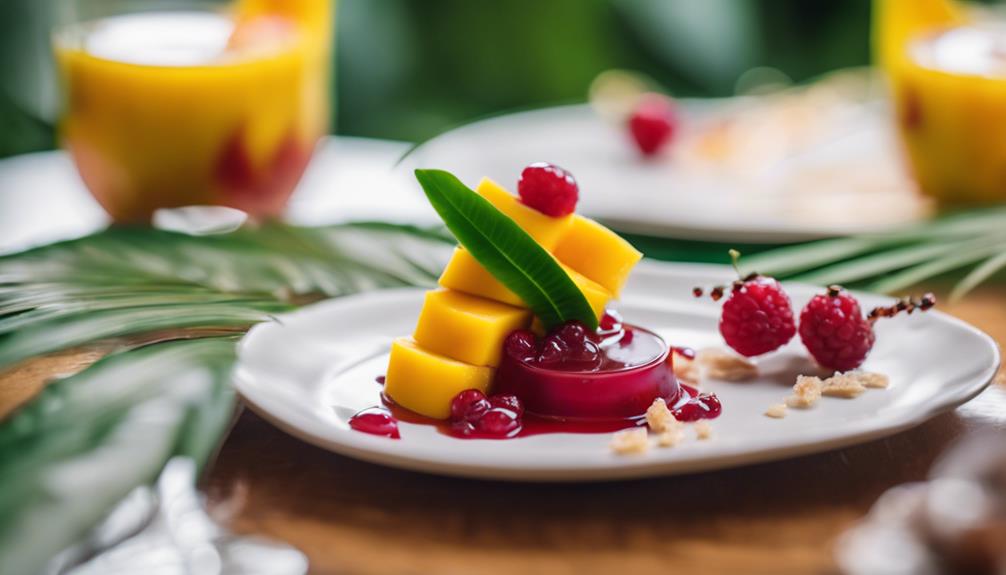
Let's talk about some delightful tropical mango treats you can enjoy.
Try making Mango Coconut Sorbet for a invigorating and creamy dessert.
Or indulge in a sweet Mango Berry Parfait that combines the tropical goodness of mango with the tartness of berries.
For a healthy option, whip up a Mango Chia Pudding packed with nutritious goodness and tropical flavor.
Mango Coconut Sorbet
To create an invigorating and tropical dessert, consider whipping up a batch of Mango Coconut Sorbet as part of the Tropical Mango Delights series. This delightful sorbet combines the richness of coconut milk with the vibrant tropical flavors of ripe mangoes, offering a revitalizing treat perfect for warm days.
Here are some key aspects of making this delicious sorbet:
- Ingredients: Gather fresh ripe mangoes, coconut milk, sugar, lime juice, and a pinch of salt.
- Preparation: Peel and dice the mangoes, then blend them with coconut milk, sugar, lime juice, and salt until smooth.
- Churning: Pour the mixture into an ice cream maker and churn according to the manufacturer's instructions.
- Freezing: Transfer the sorbet to a container and freeze for a few hours until firm.
- Serving: Scoop the Mango Coconut Sorbet into bowls, garnish with fresh mint or toasted coconut flakes, and enjoy the tropical sweetness of this delightful dessert.
Mango Berry Parfait
For a delightful twist on the tropical mango theme, consider indulging in a rejuvenating Mango Berry Parfait as part of the Tropical Mango Delights series. This layered dessert combines the sweetness of ripe mangoes with the tartness of assorted berries, creating a harmonious fruit pairing that's both invigorating and satisfying. Here are some key points to know about this delectable treat:
- Fresh Ingredients: The Mango Berry Parfait is made with fresh, high-quality mangoes and a mix of vibrant berries like strawberries, blueberries, and raspberries.
- Creamy Layers: Each parfait features luscious layers of creamy yogurt or velvety coconut milk, adding a smooth texture to the fruity combination.
- Balanced Flavors: The combination of mangoes and berries offers a perfect balance of sweet and tangy flavors, making each bite a burst of tropical goodness.
- Nutrient-Rich: This dessert not only delights your taste buds but also provides a dose of essential vitamins and antioxidants from the fruits.
- Easy Assembly: With simple layering techniques, you can effortlessly create visually appealing Mango Berry Parfaits that are perfect for any occasion.
Mango Chia Pudding
Indulge in a creamy and nutritious Mango Chia Pudding as a delightful addition to the Tropical Mango Delights series. This invigorating dessert combines the goodness of ripe mangoes with the health benefits of chia seeds, creating a satisfying treat that can be enjoyed guilt-free.
Here are some key points to enhance your Mango Chia Pudding experience:
- Chia benefits: Chia seeds are packed with fiber, protein, and antioxidants, making them a superfood addition to your pudding.
- Creative presentation: Experiment with layering the pudding with fresh mango slices or topping it with coconut flakes for an aesthetically pleasing look.
- Flavor variations: Add a splash of coconut milk or a hint of lime zest to elevate the taste profile of your pudding.
- Nutritional value: Apart from being delicious, this dessert is rich in vitamins and minerals, offering a healthy alternative to traditional sweets.
- Customizable: Adjust the sweetness by adding honey or maple syrup to suit your taste preferences while still reaping the nutritional benefits.
Sous Vide Dessert Technique
When it comes to sous vide dessert technique, you can expect precise temperature control, enhancing the flavors of your ingredients.
This method allows for consistent texture results, ensuring a perfect finish every time.
With sous vide, your desserts will achieve a level of sophistication that will impress even the most discerning palate.
Precise Temperature Control
Achieving precise temperature control is vital when using the sous vide technique for desserts like the Mango and Red Berry Compote. Temperature accuracy is essential for guaranteeing that the ingredients are cooked to perfection without any risk of overcooking or undercooking. This controlled cooking method allows for a consistent texture throughout the dessert, ensuring that each bite is just as delightful as the last.
By maintaining a precise temperature, you can also enhance the flavor infusion process. The ingredients in the Mango and Red Berry Compote will be able to slowly meld together, allowing the flavors to intensify and create a harmonious blend.
This slow cooking process at a consistent temperature ensures that the fruits release their natural juices and aromas, resulting in a dessert that's bursting with flavor.
Enhanced Flavor Infusion
To enhance the flavor infusion in your sous vide dessert, maintaining a consistent temperature is crucial. When working with exotic fruits like mango and red berries, it's vital to contemplate flavor pairing. These fruits bring a vibrant and tropical taste, perfect for creating a unique and mouthwatering dessert experience.
Incorporating infusion methods into your sous vide cooking is a culinary trend that allows for the infusion of flavors into your ingredients. By vacuum-sealing the fruits with the desired flavors and cooking them at a precise temperature, you can achieve a more intense and well-rounded taste profile.
Experimenting with different infusion techniques can elevate your dessert to new heights, offering a blend of sweet and tangy notes that complement each other perfectly. Whether it's using herbs, spices, or even a hint of citrus, the infusion process opens up a world of possibilities for creating a delectable dessert that surprises and delights your taste buds.
Consistent Texture Results
Maintaining a consistent texture in your sous vide desserts requires precise temperature control throughout the cooking process. This technique guarantees that your dessert achieves the desired texture consistency, whether you're aiming for a silky-smooth custard or a tender fruit compote.
By vacuum-sealing the ingredients and cooking them at a controlled temperature for an extended period, sous vide benefits the dessert by enhancing flavor pairing and texture consistency.
The sous vide method allows the flavors of the mango and red berry compote to meld together perfectly, creating a harmonious blend that tantalizes your taste buds. Additionally, the gentle cooking process preserves the natural textures of the fruits, resulting in a dessert that's both visually appealing and satisfying to eat.
When it comes to dessert presentation, achieving a consistent texture with sous vide guarantees that each bite is a delightful experience for you and your guests.
Final Thoughts
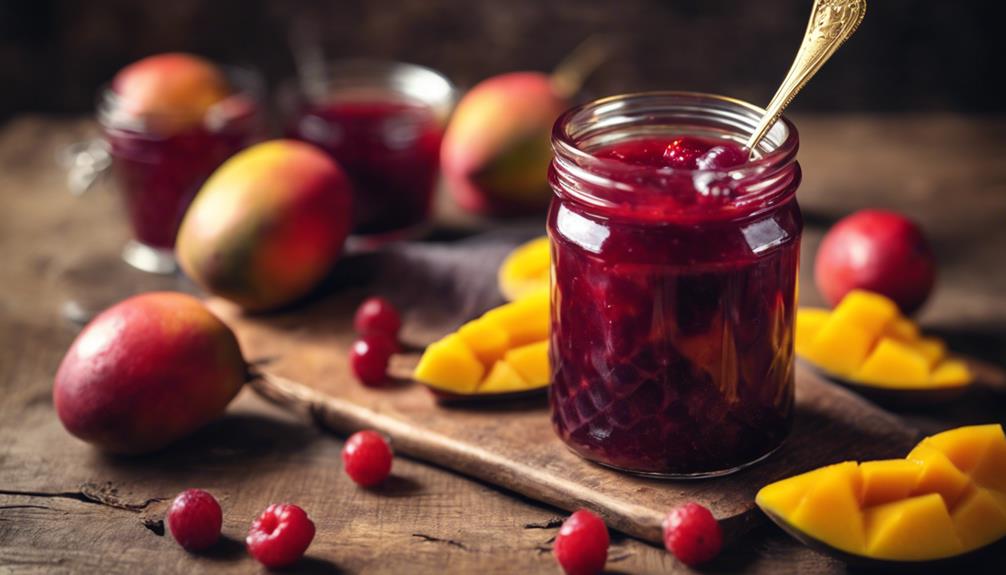
As you reflect on the delightful flavors and textures of the sous vide mango and red berry compote, consider how this versatile dish can elevate both sweet and savory dishes with its vibrant taste profile.
When exploring flavor combinations, try serving this compote over vanilla ice cream for an invigorating dessert, or alongside grilled chicken for a unique sweet and savory twist.
Cooking tips include adjusting the sous vide temperature to control the texture of the fruits, ensuring they're tender yet retain their shape.
Presentation ideas can involve layering the compote in elegant glass jars, topped with a dollop of whipped cream and a mint leaf for a visually appealing dessert.
Remember, the sous vide method allows for precise cooking, enhancing the flavors of the mango and red berries while maintaining their natural sweetness.
Experiment with different fruits and spices to create your own signature compote that will impress your guests and tantalize their taste buds.
Frequently Asked Questions
Can This Dessert Be Made Ahead of Time?
You can make this dessert ahead of time for convenience. Consider preparing components separately and assembling before serving. For presentation, layer mango and berry compote beautifully. Serve with a dollop of whipped cream. Explore flavor variations with different fruits.
Can Frozen Mango Be Used Instead of Fresh?
Yes, you can use frozen mango instead of fresh for convenience. The taste comparison may vary slightly due to texture and water content differences. Experiment to find the best fit for your dish.
Is It Necessary to Peel the Mango Before Cooking?
You should peel the mango before cooking. Keeping the skin can affect the mango texture and flavor impact. Removing the peel allows the fruit to cook evenly and absorb flavors better, ensuring a delicious outcome.
Can the Compote Be Stored in the Fridge?
You can absolutely store the compote in the fridge. Refrigeration helps preserve the flavors and extends the shelf life. Make sure to use an ideal container for maximum freshness. Enjoy your delicious dessert whenever you're ready!
Can Other Berries Be Substituted for Red Berries?
Yes, you can substitute other berries in the compote depending on your preferences. Experiment with berry options like blueberries or blackberries for different flavor combinations. Consider adjusting cooking techniques to suit the texture you desire.
Conclusion
To sum up, dessert sous vide mango and red berry compote is a delightful treat that highlights the natural flavors of mango and red berries.
The precise temperature control and gentle cooking process result in a visually appealing and delicious dessert that's perfect for any occasion.
With its sophisticated taste and vibrant colors, this dessert is sure to impress your guests and leave them wanting more.
Try making this dessert at home to elevate your culinary skills and impress your taste buds.
